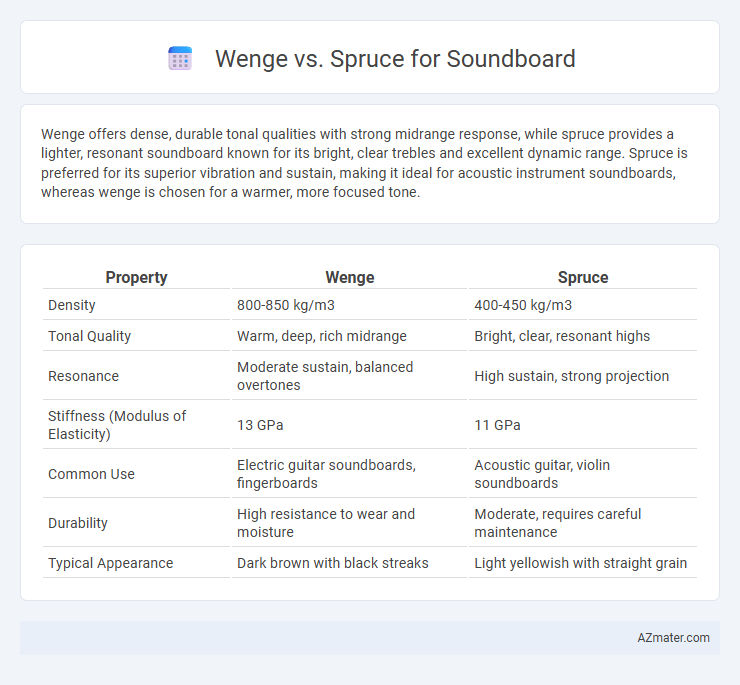Wenge offers dense, durable tonal qualities with strong midrange response, while spruce provides a lighter, resonant soundboard known for its bright, clear trebles and excellent dynamic range. Spruce is preferred for its superior vibration and sustain, making it ideal for acoustic instrument soundboards, whereas wenge is chosen for a warmer, more focused tone.
Table of Comparison
| Property | Wenge | Spruce |
|---|---|---|
| Density | 800-850 kg/m3 | 400-450 kg/m3 |
| Tonal Quality | Warm, deep, rich midrange | Bright, clear, resonant highs |
| Resonance | Moderate sustain, balanced overtones | High sustain, strong projection |
| Stiffness (Modulus of Elasticity) | 13 GPa | 11 GPa |
| Common Use | Electric guitar soundboards, fingerboards | Acoustic guitar, violin soundboards |
| Durability | High resistance to wear and moisture | Moderate, requires careful maintenance |
| Typical Appearance | Dark brown with black streaks | Light yellowish with straight grain |
Introduction to Wenge and Spruce Soundboards
Wenge and spruce are popular choices for guitar soundboards, each offering distinct tonal characteristics and structural benefits. Wenge, a dense and hard African hardwood, provides a strong midrange response and enhanced sustain, favored for its durability and rich, warm sound. Spruce, a traditional tonewood for soundboards, is known for its lightweight, resonant qualities that deliver bright, clear trebles and dynamic range, making it a preferred option for versatile acoustic guitars.
Origin and Botanical Background
Wenge, originating from Central Africa, belongs to the species Millettia laurentii and is renowned for its dense, dark brown hardwood often used in musical instrument construction. Spruce, primarily sourced from regions in the Northern Hemisphere such as Europe, North America, and Asia, derives from the genus Picea and is prized for its lightweight, resonant softwood qualities ideal for soundboards. The contrasting botanical characteristics of Wenge's hardwood fibers versus Spruce's softwood grain significantly influence their acoustic properties and suitability in soundboard applications.
Physical Properties Comparison
Wenge features a high density of approximately 800 kg/m3, offering excellent rigidity and durability, which contributes to its strong midrange sound resonance when used in soundboards. Spruce, with a lower density around 450 kg/m3, provides superior stiffness-to-weight ratio and excellent elasticity, resulting in enhanced vibration transmission and bright, clear tonal qualities. The contrasting physical properties of Wenge's hardness and Spruce's lightweight flexibility make Spruce generally preferred for soundboards due to its efficient sound projection and dynamic response.
Tonal Characteristics of Wenge Soundboards
Wenge soundboards offer a rich, warm tonal character with pronounced midrange frequencies and enhanced clarity, making them ideal for resonant, full-bodied acoustic performances. Compared to spruce, which provides a brighter and more articulate sound, wenge emphasizes depth and sustain, delivering a darker, more complex tonal palette. The dense grain structure of wenge contributes to its unique sonic properties, adding durability and a distinct tonal signature favored by players seeking a robust, earthy sound.
Tonal Characteristics of Spruce Soundboards
Spruce soundboards are prized for their bright, clear tonal characteristics, offering a wide dynamic range and excellent responsiveness. They produce a balanced sound with pronounced highs, detailed mids, and tight bass, making them ideal for versatile musical genres. Compared to wenge, which emphasizes warmth and midrange depth, spruce delivers superior projection and clarity in soundboard applications.
Durability and Stability Factors
Wenge offers superior durability for soundboards due to its dense, hard grain structure, making it highly resistant to dents and wear over time. Spruce is preferred for its excellent dimensional stability and lightweight nature, which ensures consistent resonance and reduces the likelihood of warping under varying humidity conditions. Combining wenge's toughness with spruce's stability results in a soundboard that balances long-lasting performance with optimal acoustic properties.
Workability and Crafting Considerations
Wenge offers exceptional durability and a coarse texture, which can make it more challenging to carve and shape for soundboards, requiring sharper tools and greater craftsmanship. Spruce is highly favored for soundboards due to its lightweight, straight grain, and ease of workability, allowing for precise shaping and tuning to enhance acoustic performance. Crafting with spruce demands careful attention to grain quality and drying conditions, while wenge's density provides robustness but may limit detailed acoustic tuning.
Aesthetic Appeal and Visual Differences
Wenge soundboards feature a rich, dark brown color with fine, straight grain patterns often accented by subtle, wavy textures, creating a sophisticated and exotic aesthetic. In contrast, spruce soundboards present a lighter, creamy hue with uniform, tight grain lines that emphasize clarity and brightness in appearance. The visual contrast between wenge's bold, dramatic tones and spruce's light, natural elegance makes the choice highly dependent on the desired overall look of the instrument.
Suitability for Musical Genres and Instruments
Wenge offers a dense, stiff soundboard ideal for producing strong, focused midrange tones, making it well-suited for genres like jazz and blues where clarity and sustain are crucial. Spruce, known for its lightweight and resonant qualities, delivers bright, balanced tones with excellent dynamic range, perfect for classical, folk, and acoustic guitar styles that require rich harmonic complexity. Both woods influence instrument response differently, with Wenge enhancing projection and attack, while Spruce emphasizes warmth and nuance, catering to diverse musical preferences and playing techniques.
Price, Availability, and Sustainability
Wenge wood is generally more expensive and less readily available compared to spruce, making it a premium choice for soundboards. Spruce is widely favored for its affordability, consistent availability, and excellent acoustic properties, being the standard in instrument soundboards. In terms of sustainability, responsibly sourced spruce has a better environmental profile due to faster growth rates and managed forestry practices, whereas wenge's slower growth and limited supply raise concerns about long-term sustainability.

Infographic: Wenge vs Spruce for Soundboard
 azmater.com
azmater.com